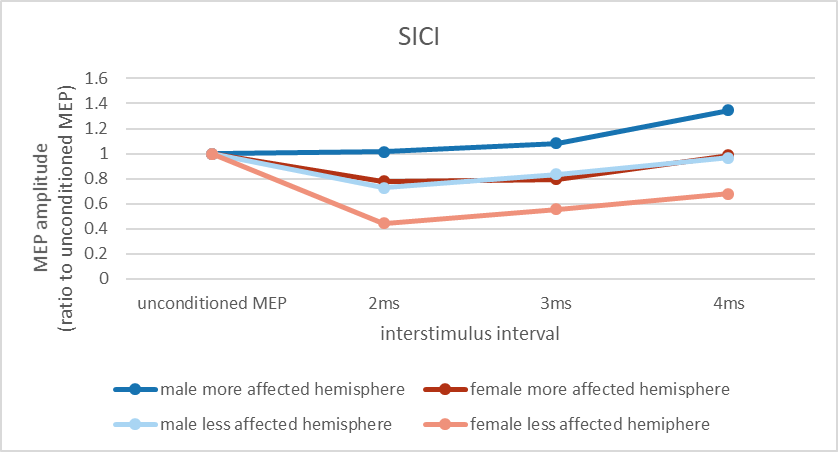Session Information
Date: Monday, October 8, 2018
Session Title: Parkinson's Disease: Neuroimaging And Neurophysiology
Session Time: 1:15pm-2:45pm
Location: Hall 3FG
Objective: In early Parkinson’s disease (PD), functional changes may be detected in primary motor cortex (M1) using transcranial magnetic stimulation (TMS). We hypothesised that, if pathophysiology differs between genders in PD, this will be reflected in differences of M1 TMS measurements.
Background: Demographic studies of Parkinson’s disease (PD) found that women are almost twice less affected than men, implying protective effect of female sex. It is not known, once the symptoms develop, if disease course differs between genders, which would suggest differences in disease pathophysiology.
Methods: Forty newly diagnosed and untreated PD patients (23 males, 17 females) were assessed using Unified Parkinson’s Disease Rating Scale (UPDRS). Motor thresholds, input/ output curve (IO curve), short interval intracortical inhibition (SICI), cortical silent period (CSP) and intracortical facilitation (ICF) were measured over both hemispheres, corresponding to less and more affected side, using TMS. Plasticity was probed using paired associative stimulation (PAS) protocol. Twenty-nine healthy participants (13 males, 16 females) completed testing on the dominant hemisphere, among them six were tested on both hemispheres.
Results: There were no gender differences in UPDRS in PD patients. Compared to male PD patients, female patients had less steep IO curve on the less affected hemisphere (p< 0,05). In both hemispheres, female patients had more preserved SICI (p< 0,05) [table1] and trend toward better response to PAS protocol. There was no difference in motor thresholds, ICF and CSP between genders in PD patients. Healthy controls showed no interhemispheric differences and no gender differences in any of the TMS protocols.
Conclusions: Less steep IO curve, more pronounced SICI and tendency toward preserved cortical plasticity in female compared to male patients with early PD suggest gender differences in disease pathophysiology. We provide first neurophysiological evidence that sex is an important factor in heterogeneity of PD.
References: The abstract will be presented at the 4th Congress of the European Academy of Neurology in Lisbon, from the 16th to 19th of June 2018.
To cite this abstract in AMA style:
K. Kolmancic, R. Alfonso, Z. Pirtosek, K. Bhatia, M. Kojovic. Gender Differences in Parkinson’s disease: Transcranial Magnetics Stimulation Study of Newly Diagnosed Drug-Naïve PD Patients [abstract]. Mov Disord. 2018; 33 (suppl 2). https://www.mdsabstracts.org/abstract/gender-differences-in-parkinsons-disease-transcranial-magnetics-stimulation-study-of-newly-diagnosed-drug-naive-pd-patients/. Accessed October 17, 2025.« Back to 2018 International Congress
MDS Abstracts - https://www.mdsabstracts.org/abstract/gender-differences-in-parkinsons-disease-transcranial-magnetics-stimulation-study-of-newly-diagnosed-drug-naive-pd-patients/

